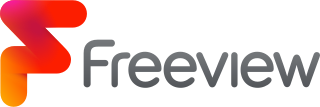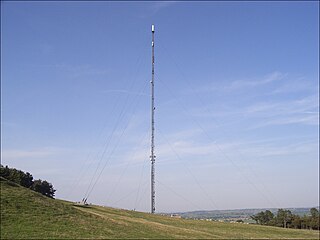
Freeview is the United Kingdom's sole digital terrestrial television platform. It is operated by Everyone TV and DTV Services Ltd, a joint venture between the BBC, ITV, Channel 4, Channel 5 and Sky. It was launched on 30 October 2002, taking over the licence from ITV Digital which collapsed that year. The service provides consumer access via an aerial to the seven DTT multiplexes covering the United Kingdom. As of July 2020, it has 85 TV channels, 26 digital radio channels, 10 HD channels, six text services, 11 streamed channels, and one interactive channel.
Television broadcasts in the United Kingdom began in 1932, however, regular broadcasts would only begin four years later. Television began as a public service which was free of advertising, which followed the first demonstration of a transmitted moving image in 1926. Currently, the United Kingdom has a collection of free-to-air, free-to-view and subscription services over a variety of distribution media, through which there are over 480 channels for consumers as well as on-demand content. There are six main channel owners who are responsible for most material viewed.
Teletext Ltd was the provider of teletext and digital interactive services for ITV, Channel 4 and Five in the United Kingdom.

The Crystal Palace transmitting station, officially known as Arqiva Crystal Palace, is a broadcasting and telecommunications site in the Crystal Palace area of the London Borough of Bromley, England. It is located on the site of the former television station and transmitter operated by John Logie Baird from 1933.

The Mendip transmitting station is a broadcasting and telecommunications facility on the summit of Pen Hill, part of the Mendip Hills range in Somerset, England, at 305 metres (1,001 ft) above sea level. The station is in St Cuthbert Out civil parish, approximately 2 miles (3.2 km) north-east of Wells. Its mast, 293 m (961 ft) high, was built in 1967 and is the tallest structure in South West England. The mast broadcasts digital television, FM analogue radio and DAB digital radio, and had broadcast analogue colour television from 1967 until 2010.
Digital terrestrial television in the United Kingdom encompasses over 100 television, radio and interactive services broadcast via the United Kingdom's terrestrial television network and receivable with a standard television set. The majority of digital terrestrial television (DTT) services, including the five former analogue channels, are broadcast free-to-air, and a further selection of encrypted pay TV services are also available.
Freesat is a British free-to-air satellite television service, first formed as a joint venture between the BBC and ITV plc and now owned by Everyone TV. The service was formed as a memorandum in 2007 and has been marketed since 6 May 2008. Freesat offers a satellite alternative to the Freeview service on digital terrestrial television, with a broadly similar selection of channels available without subscription for users purchasing a receiver.

The Moel-y-Parc transmitting station is situated on Moel y Parc, a hill in north-east Wales at the northern end of the Clwydian range, close to the town of Caerwys and several miles (kilometres) north-east of Denbigh. It was built in 1962/1963 by the IBA to bring 405-line VHF ITV television to North Wales and it has been on the air since 1963. Its original height of 229 metres (751 ft) made it the tallest structure in North Wales and it stands on land that is itself about 335 metres (1,099 ft) above sea level. In 1965, VHF television transmissions from the BBC commenced from the site.

The Wenvoe transmitting station, officially known as Arqiva Wenvoe, is the main facility for broadcasting and telecommunications for South Wales and the West Country. It is situated close to the village of Wenvoe in the Vale of Glamorgan, Wales, in the UK.
Freesat from Sky (FsfS) was a British satellite television service from Sky UK. It offered over 240 free-to-air (FTA) channels in its EPG. This is a greater number than its competitors, Freesat, which has 200+, and Freeview, which has 70+. It also had up to six HD channels and used to have Sky Active interactive data service. Sky was not actively promoting the service and the service has quietly been discontinued for new customers as of 2021.

The digital switchover was the process by which analogue terrestrial television in the United Kingdom was replaced with digital terrestrial television. It is sometimes referred to as the "analogue switch off".
The Oxford transmitting station is a broadcasting and telecommunications facility, situated on land 129.5 metres (425 ft) above Ordnance Datum to the north east of the city of Oxford, in Oxfordshire, England. It has a guyed steel lattice mast which is 154.4 metres (507 ft) in height to the top of the main steel structure. The UHF television antenna, which consist of a vertical array of transmitting panels, is mounted above the steel structure. The total height of the mast to the top of this UHF antenna is 165.7 metres (544 ft). It is owned and operated by Arqiva.
There are four major forms of digital television (DTV) broadcast in the United Kingdom: a direct-to-home satellite service from the Astra 28.2°E satellites provided by Sky UK, a cable television service provided by Virgin Media ; a free-to-air satellite service called Freesat; and a free-to-air digital terrestrial service called Freeview. In addition, an IPTV system known as BT TV is provided by BT. Individual access methods vary throughout the country. 77% of the United Kingdom has access to HDTV via terrestrial digital television. Satellite is the only source of HDTV broadcast available for the remaining 23%.
High-definition television in the United Kingdom is available via cable, IPTV, satellite and terrestrial television. The first high-definition broadcasts began in late 2005 and since then the number of channels available to view has grown to a maximum of 87 that can be viewed on pay-TV service, Sky.
Television in Northern Ireland is available using, digital terrestrial, digital satellite and cable.
YouView is a hybrid television platform in the United Kingdom developed by YouView TV Ltd, a partnership of four broadcasters, the BBC, ITV, Channel 4 and Channel 5; and three telecommunications operators, Arqiva, BT Group and TalkTalk Group.
Freeview is the name for the collection of free-to-air services on the Digital Terrestrial Television platform in the United Kingdom. The service was launched at 5 am on 30 October 2002 and is jointly operated by its five equal shareholders – BBC, ITV, Channel 4, BSkyB and transmitter operator Arqiva. This article documents the history of the Freeview service, from its inception up to the present.

The Kilvey Hill transmitting station was originally built at the summit of Kilvey Hill in Swansea, Wales, by the BBC in 1967 as a relay for VHF and UHF television. VHF television came on air a few months before the UHF services. As built, the station did not radiate VHF FM radio, this was added later. Currently, the hill's transmitters cater for viewers and listeners in the Swansea and Neath Port Talbot area. The transmission station located on top of Kilvey Hill is owned and operated by Arqiva.
The Mynydd Emroch television relay station is sited on the eponymous hill to the east of Port Talbot. It was originally built in the 1970s as a fill-in relay for UHF analogue television. It consists of a 25 metres (82 ft) self-supporting lattice tower standing on a hillside which is itself 600 ft above sea level. The transmitters are beamed southwards to cater for those digital terrestrial TV subscribers in Port Talbot and Margam which for reasons of geography can't get a signal from the Kilvey Hill transmitter across the bay at Swansea. The Mynydd Emroch transmission station is owned and operated by Arqiva.









